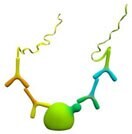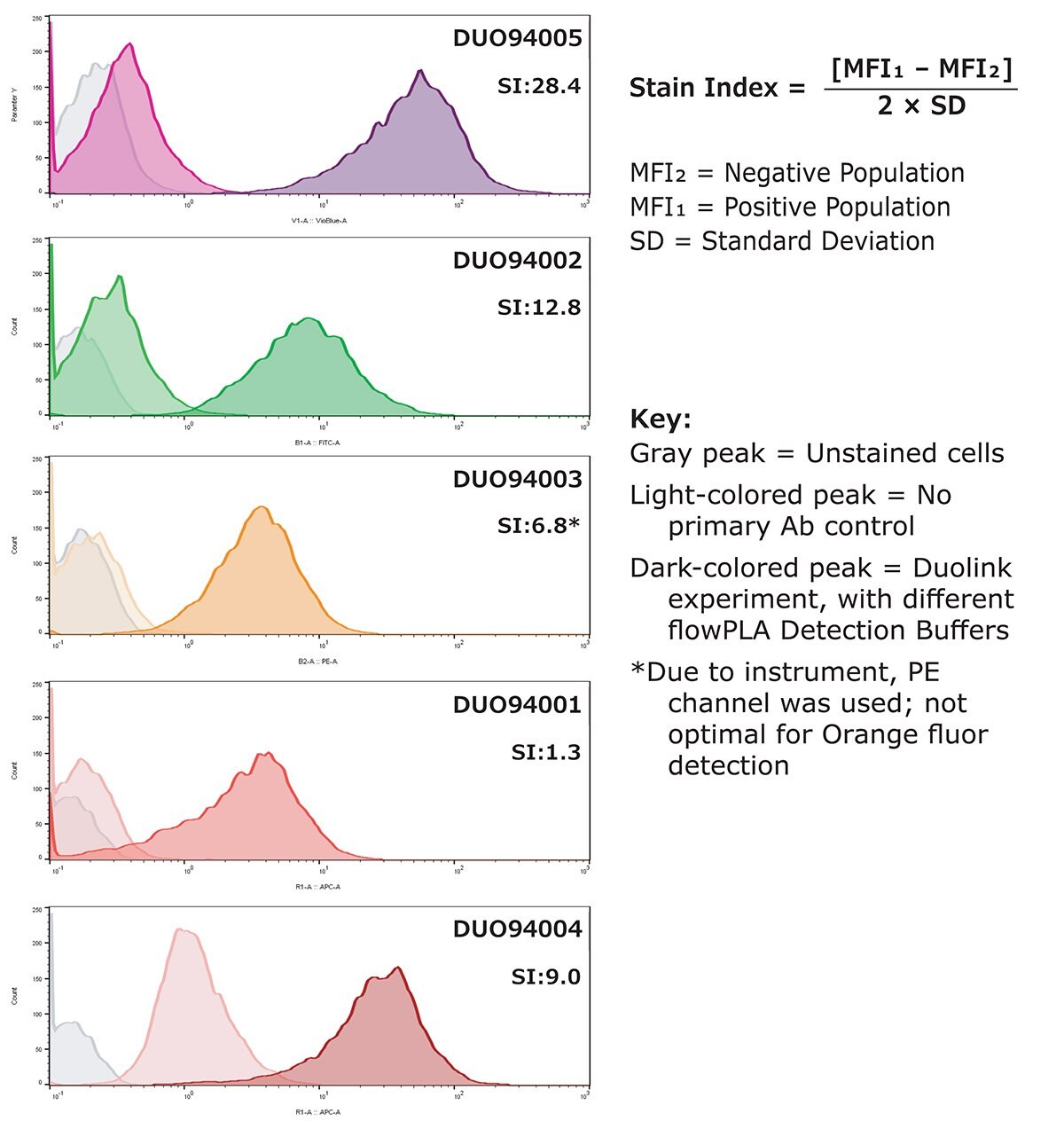How to Optimize Duolink® PLA for Flow Cytometry Detection
Adaptation of Duolink® in situ proximity ligation assay (PLA) into flow cytometry workflows allows quantitative detection of protein-protein interactions, protein post-translational modifications, and protein expression with greater statistical power. However, to successfully execute Duolink® PLA for flow cytometry detection, there are some necessary considerations for proper experimental setup and execution of the assay protocol. Duolink® flowPLA reagents can be used in traditional flow cytometry and imaging flow cytometry application formats. Review the Duolink® PLA Product Selection Guide for a complete overview on selecting the right products for your particular application.
Experimental Design
There are many factors that must be taken into account when designing a successful Duolink® PLA experiment for flow cytometry. These include but are not limited to:
- Determining the protein target and assay type
- Selecting the appropriate sample
- Devising the assay conditions
- Choosing the appropriate fluorophore for downstream data acquisition
- Designing experimental controls (technical and biological)
Target Identification
The first thing to determine is the protein target of interest. Is it the expression of a single protein, a protein-protein interaction, or a protein post-translational modification? A brief description of how Duolink® PLA can be used to detect various types of protein targets is shown below.
Detection of Single Protein Expression
There are two ways to detect a single protein target by the Duolink® PLA technology: with the use of one primary antibody (single recognition) or two primary antibodies (double recognition) against the target.
Single recognition confers the highest sensitivity and is recommended when detecting single protein targets present at low expression levels. This method is also useful when determining individual primary antibody concentrations prior to experiments that use two antibodies. However, this method is only recommended when a well-performing, specific primary antibody is available. Use of a non-specific primary antibody will result in high background due to the sensitivity of the assay.

Figure 1.Single Recognition
Double recognition provides greater specificity through the use of two primary antibodies. Each primary antibody must be directed against different, non-competing epitopes on the same target molecule. Furthermore, the two primary antibodies must be raised in different species (mouse, rabbit, goat, or human) and must bind to the target under the same experimental conditions. These conditions are delineated in the Assay Preparation section below.

Figure 2.Double Recognition
Detection of Protein-Protein Interactions
Duolink® PLA technology provides a revolutionary way to detect protein interactions with a flow cytometry read-out. This is done using two primary antibodies, each directed against one of the targets of interest, and each raised in different species (mouse, rabbit, goat, or human). The two primary antibodies must bind to the target under the same experimental conditions.

Figure 3.Detection of Protein-Protein Interactions
Detection of Protein Modifications
Detection of protein modifications, such as phosphorylation, often suffers from low specificity. The recommended strategy is to use two primary antibodies, one against the target protein and one against a specific modification site on the same protein. Alternatively, when an antibody against a site-specific modification is not available, it is possible to use a generic antibody against a modification site (e.g., anti-phosTyr). The two primary antibodies must be raised in different species (mouse, rabbit, goat, or human) and must bind to the target under the same experimental conditions.

Figure 4.Detection of Protein Modifications
Sample Selection
Performing a literature search or having prior knowledge of the cell sample and the protein target(s) is important. Choosing a system with known target protein expression will dramatically increase chances of a successful Duolink® PLA experiment. Furthermore, knowing the relative abundance of the protein expression can also help guide you with fluorophore selection.
All cell samples must be fixed prior to performing a Duolink® PLA experiment and thus is not recommended for fluorescence-activated cell sorting (FACS) analysis. As in all flow cytometry experiments, it is necessary to use suspended cells. The types of cells suitable for Duolink® PLA flow cytometry experiments are the same as those used for traditional flow cytometry, such as:
- Detached adherent cells
- Suspension cells
- Blood cells
- Primary cells isolated from tissue samples
Depending on the situation, it may be beneficial to use cell lines that are relatively homogenous as opposed to primary cells that usually consist of heterogeneous populations of cell types.
Fluorophore Selection
The Duolink® PLA Flow Cytometry protocol is agnostic for flow instrument. Duolink® flowPLA Detection Reagents should be selected based on the availability of lasers and detectors in your flow cytometer and any potential autofluorescence of the sample which may interfere with the Duolink® PLA signal. Furthermore, if combining Duolink® PLA with immunofluorescence (IF) for multicolor flow cytometry, choose fluorophores that minimize spectral overlap and reserve the brightest fluorophore option for the lowest expressing signal.
Duolink® flowPLA Detection Reagents are available in Voilet, Green, Orange, Red, and FarRed emission colors.

Figure 5.Fluor Comparision
Experimental Controls
Duolink® PLA results provide relative quantification of a protein event (expression, interaction or modification). Thus, it is important to include technical and, when possible, biological controls.
Technical Controls
Negative controls are essential to determine the extent of background signal in the system. Different types of technical controls can help determine the source of the background signal. These include:
- Omission of each primary antibody separately
- Used to detect non-specific binding of each primary antibody
- Helpful in determining optimal primary antibody titer
- Omission of all primary antibodies
- Used to detect non-specific binding of the Duolink® PLA probes in the system
- Unstained cells (incubated in parallel with the stained samples)
- Used to detect background derived from autofluorescence
Biological Controls
In addition to technical controls, the use of biological controls is highly recommended. Both positive and negative biological controls can provide valued information.
- Positive controls
- Include a separate sample with known protein expression, interaction or modification to test reagents
- Use of an inducible system (e.g., growth factor stimulation, heat shock, etc.) will provide biological relevance of Duolink® PLA signal
- Negative controls
- Use of sample not expressing the protein target(s) (e.g., knockout, silencing, etc.) will provide information on the specificity of the primary antibodies
- Use of an irrelevant antibody (e.g., isotype control IgG, antibody to a non-interacting protein, etc.) will provide information on the specificity of the primary antibodies or Duolink® PLA probes
Use of inhibitors which prevent protein interaction or modification will provide biological relevance of Duolink® PLA signal
Assay Preparation
To ensure successful execution of a Duolink® PLA experiment for flow detection, considerable preparatory work is required. This prep work is similar to that needed for immunofluorescence (IF) for microscopy or flow cytometry. Prior knowledge regarding experimental conditions for optimal performance of your primary antibodies can help avoid potential problems when performing a Duolink® PLA experiment. This section delineates considerations for primary antibody identification, antibody optimization, and sample preparation.
Choice of Primary Antibodies
The Duolink® PLA reagents are universal reagents using secondary antibodies for detecting presence of target-specific primary antibodies. The choice of primary antibodies is crucial when setting up Duolink® PLA experiments.
Requirements
The Duolink® PLA probes are donkey anti-mouse, anti-rabbit, anti-goat, or anti-human secondary antibodies; therefore, there are certain requirements of the primary antibodies. These include:
- Host must be mouse, rabbit, goat, or human (exceptions require use of Duolink® Probemaker)
- IgG class
- Can be monoclonal or polyclonal
- Affinity purified preferred to minimize cross-reactivity
- Validated by IF or flow cytometry is recommended
Use of Directly-conjugated Primary Antibodies
There are situations when the use of directly-conjugated primary antibodies is needed. The Duolink® Probemaker enables the conjugation of a PLA oligo (PLUS or MINUS) to any antibody. Considerations for using the Duolink® Probemaker are:
- When the host of a primary antibody is different than mouse, rabbit, goat, or human
- When using two primary antibodies from the same species
Primary Antibody Optimization
For successful execution of a Duolink® PLA experiment, it is important to identify the conditions for optimal primary antibody performance within the sample to be tested. Conditions for primary antibody optimization should include:
- Sample processing (fixation and permeabilization)
- Primary antibody titration
- Blocking solution and antibody diluent
Specific considerations for sample processing, blocking, and antibody diluent are described below. It is highly recommended that conditions for the primary antibodies be first identified by IF either by microscopy or traditional flow cytometry. Titrate the primary antibodies to find the optimal dilutions to achieve significant signal with minimal background. Use the recommended dilutions provided in the appropriate datasheets as a starting point. When using two primary antibodies, optimization for each primary antibody should be done separately, however sample processing needs to be compatible for optimal performance of both primary antibodies.
Once conditions are determined by IF, these conditions can then be applied to Duolink® PLA. However, primary antibody concentrations may need to be further titrated for the Duolink® PLA experiment as Duolink® PLA technology provides greater sensitivity and amplified signal compared to IF. Using the Duolink® PLA single recognition approach described above offers the greatest sensitivity when optimizing primary antibody concentrations. These conditions can then be used in Duolink® PLA experiments using both primary antibodies.
Sample Processing
Samples should be appropriately processed with respect to fixation, permeabilization, and general handling. It is crucial for the performance of the assay to optimize the conditions for the primary antibodies that are to be used in the experiment.
Fixation
Fixation is used to immobilize antigens while retaining cellular and subcellular structure. The choice of fixative may vary depending on sample type, the primary antibodies and the protein target. Different fixatives can influence the antigenicity, and thus the performance, of primary antibodies. If there is no recommended fixation for the selected primary antibodies, this must be optimized by the user. Duolink® PLA reagents are compatible with all fixations typically used for IF, including:
- Acetone
- Ethanol
- Formalin
- Methanol
- Paraformaldehyde
- Glyoxal
Of note, some fixatives (e.g., acetone, methanol, and ethanol) also cause permeabilization so an additional step to permeabilize for intracellular epitopes may not be necessary.
Permeabilization
Permeabilization is required for antibody access to intracellular epitopes. For many cytoplasmic epitopes, mild detergents (e.g., Saponin or Tween-20) are sufficient. For nuclear antigens, slightly stronger detergents (e.g., Triton-X or NP-40) may be needed. For detection of phosphorylated epitopes, methanol is often used. Fixative/Perm buffer sets are commercially available and may aid in antibody optimization. Ensure that all antibodies being used are compatible with the same fix and permeabilization conditions.
For cell surface epitopes, permeabilization is not required. However, added precautions may be needed to ensure the cell surface marker remains intact and recognized by the primary antibody. When using adherent cells, detachment with trypsin can remove surface epitopes or induce internalization of some cell surface proteins. Thus, more gentle detachment methods (e.g., 1-10mM EDTA, cell dissociation buffers, or Accutase®) are recommended.
General Sample Handling
Quality sample preparation to ensure single cell suspensions is critical for flow cytometry. If the cell sample is clumpy or contains significant amount of cell debris, the ensuing data may be difficult to analyze. The following steps can minimize cell clumping or cell damage:
- Use Ca++ and M++ free buffers (addition of 1-5 mM EDTA optional)
- Avoid bubbles, vigorous vortexing, and excessive centrifugation
- Filter your samples with mesh strainers
Cell sample preparation for flow cytometry commonly involves the use of U-bottom or V-bottom 96-well plates or flow cytometry tubes and multiple rounds of centrifugation during wash steps which can lead to significant cell loss. The following steps can minimize cell loss:
- Avoid disturbing the cell pellet during removal of buffer
- Centrifugation speed may be increased, however excessive centrifugation can cause clumping (needs to be empirically derived).
- Addition of BSA or FBS in wash buffers
- Use of filter plates or filter cups
- Use of cell washer instruments
Blocking Solution and Antibody Diluent
Duolink® Blocking Solution and Antibody Diluent are provided with the Duolink® PLA probes (PLUS and MINUS). These solutions have been optimized for use with Duolink® PLA reagents to minimize non-specific binding of the antibodies and detection oligos. However, it is important to verify that your primary antibodies bind specifically to the protein targets of interest under these conditions. Each primary antibody should be tested separately using the Duolink® PLA single recognition assay or possibly by IF.
If you have previously identified a blocking solution and/or antibody diluent compatible with the primary antibodies of choice in IF staining, it is likely that these can also be used in Duolink® PLA experiments. When using cells such as B cells, monocytes, or macrophages, an Fc blocker or unlabeled donkey IgG can be added to the blocking solution to minimize antibody binding to the Fc receptors. Isotype IgG from the same species as your primary antibodies should not be used as the Fc receptor blocking reagent as this will cause false signals from the Duolink® PLA probes.
Reaction Volume
Recommended reaction volume for Duolink® PLA experiments for flow cytometry detection is 100μl per 100,000 cells. This reaction volume should be sufficient for high-abundant interactions. For rare or low-abundant interactions, the number of cells per 100μl reaction volume can be increased and must be optimized by the user. Ensure the cells are resuspended in reaction volume throughout the protocol and avoid cell clumping.
When Duolink® PLA detection has been completed, resuspending the cell sample to 1x106-5x106 cells/mL PBS is recommended for analysis. Higher cell concentrations may clog the flow cytometer and/or affect resolution. However, you should consult the specifications of your instrument for the appropriate cell concentration and flow speed for analysis.
References
To continue reading please sign in or create an account.
Don't Have An Account?